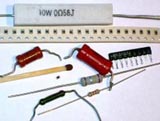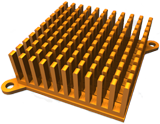
Design of DMX LED Wash Lights
Not Finished yet, it will be expanded soon. Covers all the parts that are required to build a LED wash light.
Controller:

The LED Controller utilizies a microcontroller to translate a DMX Signal or to read any user inputed controls and outputs a PWM Signal that is used to control an LEDs apparant brightness. Could be an Arduino board, a
PIC based board, or any of the various other LED controllers out there.
Current Regulation:

Perhaps the most important part of the light. All LEDs require that the current they receive be regulated to their rating. A 3w uses approx. 700ma, 1w uses 350ma, 5mm uses 20ma. The simplest method
is to use resistors in series with the LED(s), but it is the most inefficient, converting extra current to heat in the resistor. The amount of wasted current is proportional to the input voltage to the LED's forward voltage. Running a 3.2v LED at 12v will create a lot more heat than the same 3.2v forward voltage LED ran at 3.5v while limiting the current to the same value.
RGB LED Strip runs on 12v, since it is 3 RGB LEDs in series, and does not require any current limiting because it has onboard resistors.
Heatsink:

The LEDs and possibly the current regulation will need to dissipate heat that is created during use. Standard method is aluminum heatsinks with fins.(pictured) A fan may be added to the case to remove
heat from the enclosure. An easy method for star mounted LEDs is to use aluminum bar, 0.75" wide, available at all hardware stores, easy to cut, easy to bend, easy to mill/drill, moves heat adequately.
Light Emitting Diodes:

The main event, all the other hardware supports the workings of these. There are many many different types, variations, configurations to choose from. They require a certain voltage called Forward Voltage to produce light, usually 2.2v for red, and 3.2v-3.6v for blue, regardless of wattage(excluding certain types that are actually multiple LEDs in series on the die) In addition to forward voltage, a LED requires current. Varying current or on/off time will vary the brightness of LED, an LED has a max current which shouldn't be exceeded under most circumstances.
Some LED configurations such as LED Light Strip and certain high-wattage LEDs are containt multiple LEDs in series and thus have different working(forward) voltages.
Power Supply:

Produces a DC Voltage from an AC source. Required voltage varies depending on LED and current regulator configuration. To find required Amp rating:
LED current x Amount of Colors x %125
Example with 3 watt LEDs: 700ma x 3(R-G-B) = 2.1A x %125 = 2.65A
2.1A is calculated to be the most the LEDs will draw when all full on, the %125 is a safety margin to avoid over-drawing the PSU.
Diagrams and more pictures will be added soon!